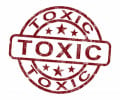Effects of Toxicants on Population and Ecosystem
Effects of Toxicants on Population and Ecosystem

Effects of Toxicants on Population and Ecosystem
1.Concept
A xenobiotic species is one that is foreign to living systems. Common examples include heavy metals, such as lead, which serve no physiologic function, and synthetic organic compounds, which are not made in nature. Exposure of organisms to xenobiotic materials is a very important consideration in environmental and toxicological chemistry. Chemicals that have posed major environmental hazards tend to share three insidious characteristics: environmental persistence, the propensity to accumulate in living things, and high toxicity. Ecotoxicology involves the study of the adverse effects of toxicants on myriad of organisms that compose ecosystems ranging from microorganisms to top predators. Actually the toxicants have adverse effects on the populations and the ecosystems.
2.Toxicants
There are numerous or various kinds of toxicants those may cause alterations in ecosystems.These are normally regarded as pollutants from anthropogenic sources as well.Examples of such naturally occurring toxicants are H2S from geothermal sources or heavy metals such as Lead(pb) leached from mineral.The metals of most concern are called the heavy metals, specially Cd, Pb, Hg.As is commonly classified as a heavy metal for a discussion of its toxicity but it is a mettaloid as it has both mettalic and non-mettalic properties.Though not partcularly toxic Zn is aboundant and may reach toxic levels in some cases.For example Zn accumulates in sewage sludge and crop productivity has been lowered on land fertilized with sludge because of Zn accumulation.
3.Classes of Toxicants
There are various kinds of toxicans in our natural environment.The major classes of toxicants are given below:
·Persistent organic pollutants-DDT,Aldrin, Dieldrin etc.
·Easily degraded pollutants.
·Heavy metals
·Non metallic inorganic species etc. i.e. NO3
·Radioactive pollutants.
4.Effects of toxicants
Industrial and agricultural endeavors are intimately associated with the extensive use of a wide array of chemicals.The chemicals are generally like as various metals, mettaloids etc.They are referred to as toxicants. Historically chemical wastes generated through industrial processes were disposed of through flagrant release into the environment. Gasses quickly dispersed into the atmosphere; liquids were diluted into receiving waters and efficiently transported away from the site of generation. quickly dispersed into the atmosphere; liquids were diluted into receiving waters andefficiently transported a way from the site of generation. Similarly pesticides and otheragricultural chemicals revolutionized farm and forest productivity. Potential adverseeffects of the application of such chemicals to the environment were viewed a sinsignificant relative to the benefits bestowed by such practices. Carson graphically described incidents of massive fish andbird kills resulting from insecticide use in areas ranging from private residences to the national forest.
Environmental toxicology is defined as the study of the fate and effects of chemicals in the environment. Although this definition would encompass toxic chemicals naturallyfound in the environment (i.e., animal venom, microbial and plant toxins), environmentaltoxicology is typically associated with the study of environmental chemicals ofanthropogenic origin. Environmental toxicology can be divided into two subcategories: environmental health toxicology and ecotoxicology. Environmental health toxicology is the study of the adverse effects of environmental chemicals on human health, while ecotoxicology focuses upon the effects of environmental contaminants upon ecosystems and constituents thereof (fish, wildlife, etc.). Assessing the toxic effects of chemicals on humans involves the use of standard animal models (i.e., mouse and rat) as well as epidemiological evaluations of exposed human populations (i.e., farmers and factory workers). Further, comprehensive insight into the effects of chemicals in the environment requires assessments ancillary to toxicology such as the fate of the chemical in the environment and toxicant interactions with abiotic (nonliving) components of ecosystems. Comprehensive assessments of the adverse effects of environmental chemicals thus utilize expertise from many scientific disciplines. The ultimate goal of these assessments is elucidating the adverse effects of chemicals that are present in the environment and predicting any adverse effects of chemicals before they are discharged into the environment (prospective hazard assessment).
5.Effects of toxicants on Population
In biology, a population is the collection of inter-breeding organisms of a particular species; in sociology, a collection of human beings. Statistical study of human populations occurs within the discipline of demography. This article refers mainly to human populations.
5.1 Effects of toxicants on individuals
For the most part, toxicology considers the effects of toxicants on individuals. However, ecotoxicology is more concerned with toxic effects on large numbers of individuals composing populations of organisms. A population in ecological terms refers to total numbers or numbers per unit area of a particular species in an ecosystem. The average population of a species that an ecosystem can support is its carrying capacity. Exposure to toxicants is likely to lower populations by lowering reproductive rates, causing mortality, or weakening members of the species so that theybecome more vulnerable to predation, disease, or parasites. In severe cases of exposure to toxicants, a population may go to zero and stay there so long as exposure continues or, if the toxicant is removed, until immigration from outside the ecosystem restores the population.
In other cases, the population is reduced and remains at a lower level so long as exposure to the toxicant continues. Another possibility is for a population to decline, and then rise again as the population develops resistance to the effects of the toxic substance. This effect has been observed in the case of exposure to insecticides of insects whose short reproductive times enable natural selection to build populations resistant to the insecticides. Decreased populations due to exposure to toxic substances may result from mortality to members of the population or from adverse effecton reproduction. Increased mortality obviously decreases numbers directly, but it also results in decreased numbers because of fewer adults capable of producing young.
Effects of toxicants on populations may be indirect. There have been cases reported in which herbicides destroyed weed species that served as sources of food for certain kinds of insects that, in turn, were the food source for particular species of birds. Spraying with these herbicides resulted in decreases in bird populations because of the destruction of their insect food sources. Toxicants have been known to result in increases in some populations. This occurs when organisms that are predators to a particular species are poisoned, allowing the species to increase in numbers.
5.2 Effects of toxicants on Community
Toxicants attacks the individuals and finally the whole community are affected.Inferences about communities from population or individual measurements are commonplace but definitive only if the question of emergent properties is addressed carefully.This is the general challenge of any attempt at microexplanation and can result in inaccurate prediction.For example, community structure can be directly changed by the removal of one keystone species, a species that influences the community by its activity or role, and not its numerical dominance.Removal of a sea urchins from a rocky intertidal pool results in a very dramatic shift in the composition of epilithic algal species and biomass(Paine and Vadas 1969). A toxicant that kills urchins could produce a fundamental change in algal communities without having a direct effect on algal species.Field(post et al. 1995) and labortory (Taylor et al. 1995) studies with freshwater invertebrates also suggest changes in community intercations as a consequence of toxicant exposure.Whether microexplanation would have predicted the importance of these interactions among populations based on community status is uncertain.
6.Effects of Toxicants on Ecosystems
An ecosystem consists of a variety of communities of organisms and their surrounding environment
existing in a generally steady state. An important aspect of ecosystems is the flow of energy and materials. In an ecosystem intricate relationships exist among the organisms with each other and with their surroundings and these relationships may be perturbed by the effects of toxicants. The flow of materials inherent to ecosystems may be involved in the dispersal of and exposure to toxicants. Exposure to xenobiotics may alter the homeostasis (same-state status of equilibrium with surroundings) of individual organisms, leading to effects on populations of speci.c kinds of organisms, communities of organisms, and whole ecosystems.
Ecosystems can be divided generally into two categories: terrestrial ecosystems, consisting of those that exist primarily on land, and aquatic ecosystems, composed of those that exist in water. There are many interconnections between terrestrial and aquatic ecosystems, and many ecosystems have both terrestrial and aquatic components. Aquatic ecotoxicology is relatively more simple than terrestrial ecotoxicology. Exposure of organisms to toxicants in aquatic systems is normally through direct contact of the organisms with contaminated water, which can be analyzed chemically for the presence of toxicants. The organisms in aquatic ecosystems are largely con.ned to relatively small areas, although there are exceptions, such as salmon, which migrate over great distances to reproduce.
6.1 Toxic effects on Terrestrial ecosystems
Terrestrial ecotoxicology is complicated by a number of factors. Large numbers of organisms exist at various trophic levels, .tting into a variety of parts of food webs and occupying a variety of ecological niches. Terrestrial animals may move significant distances as they forage, migrate, defend their territories, and seek locations more amenable to their existence. Whereas a body of water exhibits a high degree of inertia, particularly toward changes in temperature because of water’s high heat capacity, terrestrial environments may undergo sudden and dramatic changes in temperature, moisture, and other factors that affect the environment. It is against such a variable background that the terrestrial ecotoxicologist must attempt to determine the effects, often subtle and small, of xenobiotic chemicals, which are often present at low and variable concentrations. It is not surprising, therefore, that the earliest evidence of terrestrial ecotoxicological effects dealt with particularly high levels of obvious poisons, such as arsenic compounds that were applied in huge quantities to orchards. One of the de.ning works of ecotoxicology was performed on raptor bird populations in the United Kingdom in the 1960s. Studies of peregrine falcon (Falco peregrinus) and sparrow hawk (Accipiter nisus) revealed that declining numbers of these birds were due to low hatches, a consequence of eggshell thinning from exposure to DDT metabolites and other organochlorine compounds.
Populations of organisms in ecoystems may reflect exposures to toxicants. Observations of effects on populations of organisms or on entire ecosystems are considered to be higher order end points in toxicological studies than are observations of effects on individual organisms. A severe decline in populations of a particular kind of organism may be the result of the direct effects of a toxic substance on the population. This was the case of drastically reduced populations of eagles exposed to insecticidal DDT, which prevented production of eggs capable of hatching. Populations may reflect indirect effects of toxicants, such as an overpopulation of rodents resulting from reduced numbers of birds of prey killed by toxicants. Population distributions between young and older organisms and between sexes may be altered by toxic substance exposure. During times when DDT and other organochlorine insecticides were widely used, declines in some populations of female ducks were observed. These ducks died because they accumulated large amounts of fat tissue contaminated with organochlorine compounds prior to the season in which they laid eggs. These stores of fat were rapidly used during egg production and incubation, leading to a release of high levels of toxic organics into the blood of the female ducks and causing fatal poisoning to result. Effects on population distributions may serve as evidence of kinds of toxicants. A marked decrease in numbers of juveniles may indicate the presence of reproductive poisons. A low population of older individuals can result from exposure to carcinogens, which take a relatively long time to act, so that older members develop cancer and die.
Many of the factors that can affect organisms adversely are inherent stressors, including availability of nutrition, water quality, temperature and other climatic extremes, disease, and predation. It is important to be able to separate effects of inherent stressors from those of toxic chemicals. There are often important synergistic relationships between inherent stressors and the effects of toxic chemicals. Organisms that are under stress from inherent stressors are likely to be more susceptible to the effects of xenobiotic toxicants.
6.2 Sublethal effects
Observation of deaths of organisms and resultant declines in populations, though straightforward and unequivocal, are often insuf.cient to fully explain the effects of toxic substances on ecosystems. It is also important to consider sublethal effects, which may cause ill effects in populations without directly killing individuals. Exposure to toxicants can lower reproductive rates of organisms and affect rates of survival of juveniles to adulthood. Ability to avoid predators may be curtailed, foraging capabilities may be reduced, and homing and migration instincts may be adversely affected. A number of tests are used to monitor sublethal effects. One such test examines the induction of mixed-function oxygenase enzymes, which are produced by organisms to metabolize toxicants. The presence of stress proteins that serve to repair proteins denatured by toxicants can be evidence of an organism attempting to cope with sublethal effects of toxicants. The activity of the acetylcholinesterase enzyme can be measured as evidence of the harmful effects of organophosphate and carbamate insecticides. Genotoxicity (such as damage to chromosomes) and immune system effects can also be monitored for evidence of sublethal effects.
6.3 Pollution-induced community tolerance
It has been observed in ecoystems in which communities that are resistant to the effects of some kinds of pollutants have survived. Additional exposure to the same pollutants may have relatively little effect because the organisms that have survived are those that tolerate the particular kinds of pollutants in question. Exposure of an ecosystem to toxic substances may result in the disappearance of entire populations, which in turn may enable larger populations of competing organisms to develop or may result in loss of populations dependent upon those directly affected by the toxicants. Such an occurrence obviously involves loss of species diversity, which is an important characteristic of healthy ecosystems. More commonly, populations are reduced, resulting in a shift in the distribution of populations within the ecosystem.
6.4 Acid effects on freshwater ecosystems
Some of the most well studied effects of toxic substances on ecosystems have been those dealing with the effects of acid on freshwater ecosystems. Declines of pH from a nearly neutral range of 6.5 to 7.5 to values around 5.5 to 6.0 have been observed in some Scandinavian lakes during the approximate 30-year period following 1940. These declines have been accompanied by dramatic losses of commercially valuable salmon and trout populations. Lakes with pH values less than about 5.0 have become free of .sh. Experimental studies of lake acidi.cation have also shown changes in the phytoplankton and zooplankton communities, with a general loss of population diversity. In some cases, mats composed of just a few species of .lamentous green algae changed the entire character of the lakes.
6.5 Toxic effects on nutrient cycles
The influence of toxic substances on nutrient cycles can also be important. One of the more important nutrient cycles is the carbon cycle: carbon from atmospheric carbon dioxide is .xed as organic carbon in plant biomass, biomass is consumed by organisms, and carbon in decaying biomass is released back to the atmosphere as carbon dioxide, with a concurrent release of phosphate, nitrogen, and other nutrients. Toxic substances may cause perturbations in such a cycle, as has been observed when toxic heavy metals in soil have killed populations of earthworms, which are important in biomass recycling.
7.Conclusive Remarks
The identification and description of the effects of significant environmental contaminants and other anthropogenic processes capable of disrupting ecosystems. Major pesticides (including organophosphorus and carbamate anticholinesterases and persistent organ chlorines), petroleum and PAHs, heavy metals (lead and mercury), selenium, polyhalogenated aromatic hydrocarbons, and urban runoff. Environmental factors have long been shown to influence the toxicity of pollutants in living organisms. Factors discussed include temperature, salinity, water hardness, pH, oxygen tension, nonionizing radiation, photoperiod, and season. Accordingly, it is concluded that effects of abiotic environmental variables should be considered and factored into risk assessments of anthropogenic pollutants. The two main approaches to monitoring of toxic chemicals are workplace monitoring, using samplers that sample xenobiotic substances from workplace air, and biological monitoring. Furthermore, biological monitoring is very useful in determining the effectiveness of measures taken to prevent exposure, such as protective clothing and hygienic measures. Peoples should aware of the use of chemicals in the various purposes. Finally, to mitigate the effects of toxicants in our natural environment we should minimize the use of pesticides and other chemicals in terrestrial and the aquatic systems.
8.References
·Manahan, Stanley E. Toxicological chemistry and biochemistry by Stanley E. Manahan. -- 3rd ed.,2003.
·Handbook of ecotoxicology / David J. Hoffman [et al.] — 2nd ed.,2003.
·A.Timbrell, John /Introduction to Toxicology-2nd ed, 2003.
·Google search.








